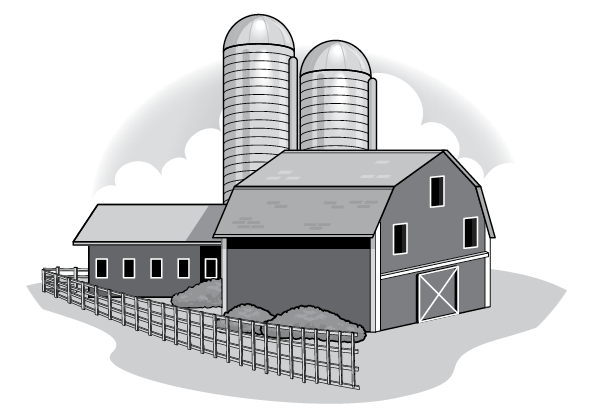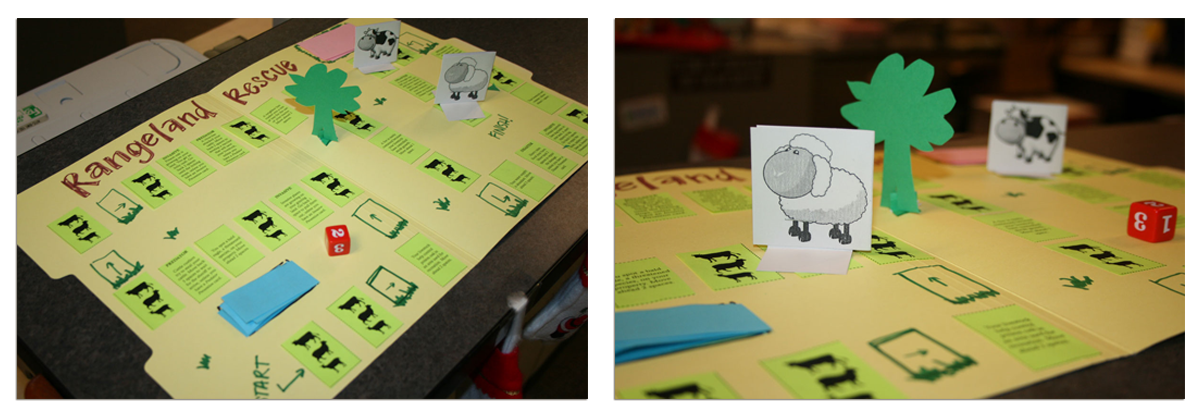 Relevancy and Engagement
learnaboutag.org
Relevancy and Engagement
learnaboutag.org
Homes on the Range
Grade Level
Purpose
Students design a board game that reinforces how rangelands provide habitat for livestock and wildlife while benefiting humans, animals, and plants and explore the responsibilities of a range manager. Grades 3-5
Estimated Time
Materials Needed
- Homes on the Range T-chart handout
- Homes on the Range PowerPoint Slides (optional)
- Rangeland Rescue Game (Instructions, Rescue Cards, Gameboard Spaces, Fact Cards, and Grading Rubric), 1 per group
- 6-sided die, 1 per group
- File folder, 1 per group
- Colored paper
- Crayons, colored pencils, or markers
- Index cards
- Scissors
Vocabulary
habitat: the natural home or environment of an animal, plant, or other organism
pasture lands: land used for grazing livestock that is planted and maintained by farmers and ranchers
range managers: a career with responsibility in maintaining, protecting, and improving range resources such as soil, water, plants, and animal life
rangeland: large, mostly unimproved section of land that is primarily used for grazing livestock
Did You Know?
- Rangelands occupy 40-50% of the land area of the Earth.1
- Rangelands support livestock for farmers and ranchers in addition to the wildlife indigenous to the area.1
- Rangeland managers typically have a bachelor's degree.2
Background Agricultural Connections
This lesson is one in a series of five related lessons to promote the development of STEM abilities and critical thinking skills, while fostering an appreciation for the people involved in livestock production. For more information about what STEM is, why it's important, and how it can be implemented in your classroom, watch the video, What is STEM? The curriculum includes real-life challenges for students to investigate, inquiry-based labs, and opportunities to plan and construct models. Featured careers include:

- Animal Physiologist: Significant Surroundings
- Agricultural Engineer: Build it Better
- Animal Geneticist: Roll of the Genes
- Animal Nutritionist: Got Guts?
- Range Manager: Homes on the Range
Rangelands are vast natural landscapes that include grasslands, shrublands, woodlands, forests, tundra, wetlands, and deserts. Rangelands do not include barren desert, farmland, or land covered by bare soil, solid rock, concrete, or glaciers. Rangelands are uncultivated lands that will provide the necessities of life for grazing and browsing animals. Rangelands are distinguished from pasture lands because they grow naturally occurring vegetation rather than plants cultivated by humans with irrigation, fertilizers, and other additions. From the wide open spaces of Northern California to the vast plains of Africa, rangelands are found all over the world, encompassing more than half of the Earth’s land surface.
Rangelands also provide important habitat for domestic livestock, including cattle, sheep, goats, and horses. These animals graze the land, feeding on plants, such as grasses. Grazing is important in agriculture, because domestic livestock convert grass and other forage into meat, milk, and other products.
There are many benefits to livestock grazing, including reducing fire hazards, promoting plant life, and encouraging wildlife species. Properly managed livestock grazing helps reduce fire hazards by controlling the amount and distribution of grasses and other potential fuel. Additionally, livestock grazing controls the growth of non-native grasses and herbs so that desirable plants (wildflowers and native grasses) can regenerate and coexist with them. Many species, including several threatened species, benefit from the vegetation management performed by livestock.
Rangelands are an important resource. They preserve open space and provide recreational uses, natural beauty, wildlife habitat, water purification, and clean air. Approximately 70 percent of the planet and 50 percent of the United States is rangeland.
Range managers care for our country’s vast rangelands. They maintain plants for forage; wildlife for aesthetics and hunting; livestock for meat, milk, and fiber production; and clean water. In this lesson, students will learn the basics about rangelands and use their acquired knowledge and research skills to design an educational game.
Refer to the Answers to Commonly Asked Questions for more background information.
Engage
- Begin a discussion with your students by asking them, "What is a rangeland?" Allow students to offer answers using their prior knowledge. Guide the discussion using the information found in the Background Agricultural Connections section and help students distinguish between a rangeland and pasture lands. Ask students:
- How are natural resources, like public rangelands, used in agriculture?
- How can agricultural use benefit rangelands?
- Inform your students that they will:
- design a board game about rangelands;
- learn about the responsibilities of a range manager;
- predict the outcome of an investigation;
- conduct an experiment to test a hypothesis;
- create a double bar graph; and
- use appropriate tools to measure length, width, depth, and perimeter.
Explore and Explain
- Distribute the Homes on the Range T-chart handout to students and project a copy onto a large screen. Demonstrate how students can use the graphic organizer to record notes.
- Lead a discussion with the students to build background information about rangelands in your state. Optional: Use the PowerPoint, Homes on the Range: An Introduction to Rangelands to help students visualize and better understand what rangelands are. The Classroom discussion should include the following points:
- "What are rangelands?" (Rangelands are vast natural landscapes that include grasslands, shrublands, woodlands, forests, tundra, wetlands, and deserts. It is land that can be used for grazing, foraging, wildlife habitat, aesthetics, hunting, and a clean water supply.)
- "Who uses rangeland?" (Ranchers, hunters, hikers, scientists, wildlife, and livestock. Ask students to share ways they have personally used rangeland, emphasizing the value of rangeland to humans, animals, and plants.)
- How can grazing animals improve rangeland? Grazing animals…
- Reduce the amount of fuel (grasses and shrubs) for wildfires. Land that is grazed is less likely to experience severe fires.
- Increase aeration of the soil, facilitating better water absorption. Their hooves break up hard ground, adding beneficial air to the soil.
- Control the growth of the non-native grasses and plants so that other desirable plants (wildflowers and native grasses) can thrive.
- Increase the diversity of habitats available to wildlife species. Many species, including several threatened species, benefit from livestock controlling the growth of invasive plants.
- What role does a range manager have in the health of our land? The range manager makes decisions about how to carefully use and manage rangeland resources (plants, animals, soil, and water) to meet the needs and desires of society. When managed properly, rangelands provide habitat for livestock and wildlife while benefiting humans, animals, and plants.
- What does a range manager do? A range manager may work with ranchers, scientists, and others to monitor plant growth, create agreements among rangeland users, develop conservation plans to meet land goals, manage private livestock operations, and develop methods to protect the range from fire, unwanted wildlife, and poisonous plants.
- Introduce the students to the game, Rangeland Rescue. Explain that in this activity, students will take on the role of range managers to help a game board manufacturer create a realistic board game about rangelands. The manufacturer has provided instructions and game board spaces. Students must use these resources to design their game board. Review the Rangeland Rescue Game Instructions out loud as a class. Tell students that this handout is their instructions for playing the game.
- Distribute and review the Rangeland Rescue Game Design handout. Tell students that this handout is their instructions for designing the game. Show students an example of the game board pictured below. Divide the class into groups of four. Distribute the necessary materials.
- Once game boards are complete, each student will evaluateanother group’s game board, using the Rangeland Rescue Game Design Grading Rubric. Students should play the game completely prior to filling out the rubric. The teacher will review the completed rubrics and average the student-determined evaluation scores for grading.
- Debrief the activity to highlight significant discoveries. Use the Range Fact Cards to guide discussion and quiz students on the information they learned about rangelands and range managers.

Variations
- Have students use library, classroom, and Web resources to design their own Range Fact Cards. Each Range Fact Card must feature a question about rangelands. Questions may be true/false, multiple choice, or short answer. Students should print questions and answers neatly on index cards for use in the game. Use an electronic presentation to introduce the topic.
- Distribute the Homes on the Range T-Chart electronically and have students fill them out on their tablet computer.
ELL Adaptations
- Give students a copy of the lesson’s Background Agricultural Connections, which provides additional information about rangelands and range managers. Lead students in highlighting and annotating the text to identify important information.
- Use games such as Pictionary or Bingo to reinforce challenging new vocabulary words.
- The “Think-Pair-Share” technique increases student engagement and is an effective way to encourage English language learners to express new concepts in English. Give students time to write a response to a question on paper, additional time to discuss their ideas with their neighbor, and then solicit responses from the entire class.
Elaborate
-
Design product packaging and a commercial for the game. Include the box, instructions, and optional add-on packs. Create a video of actual game play to help build interest.
-
Have students explore the educational background and skills required to be a range manager.
Evaluate
After conducting these activities, use the following questions to review and summarize key concepts:
- Which Range Fact Card surprised you? Why?
- What skills are important for a range manager to have?
- Why is rangeland important?
- What would life be like without rangelands?
Sources
- http://www.britannica.com/science/rangeland
- http://rangelandswest.org/careersandeducation/faqs
Acknowledgements
This unit was funded in 2012 by the United States Department of Agriculture’s National Institute of Food and Agriculture through the Secondary Education, Two-Year Postsecondary Education, and Agriculture in the K-12 Classroom Challenge Grants Program (SPECA). Images submitted by California Foundation for Agricultural Education.
Executive Director: Judy Culbertson
Illustrator: Erik Davison
Layout and Design: Nina Danner